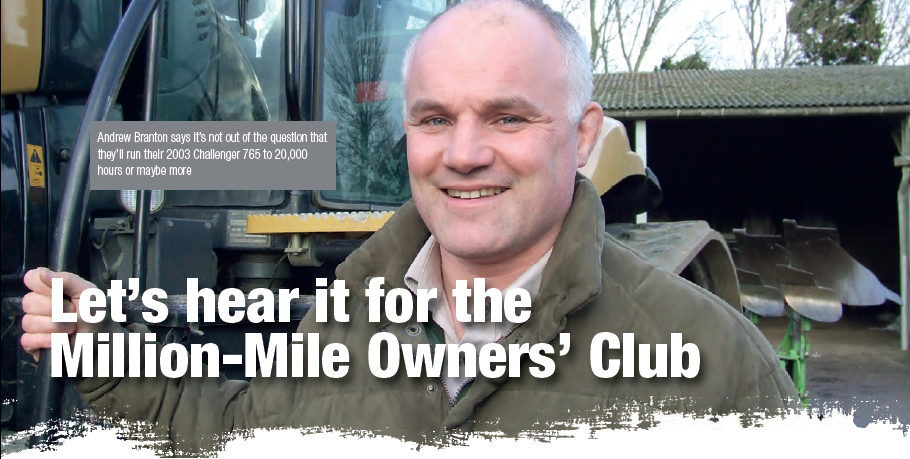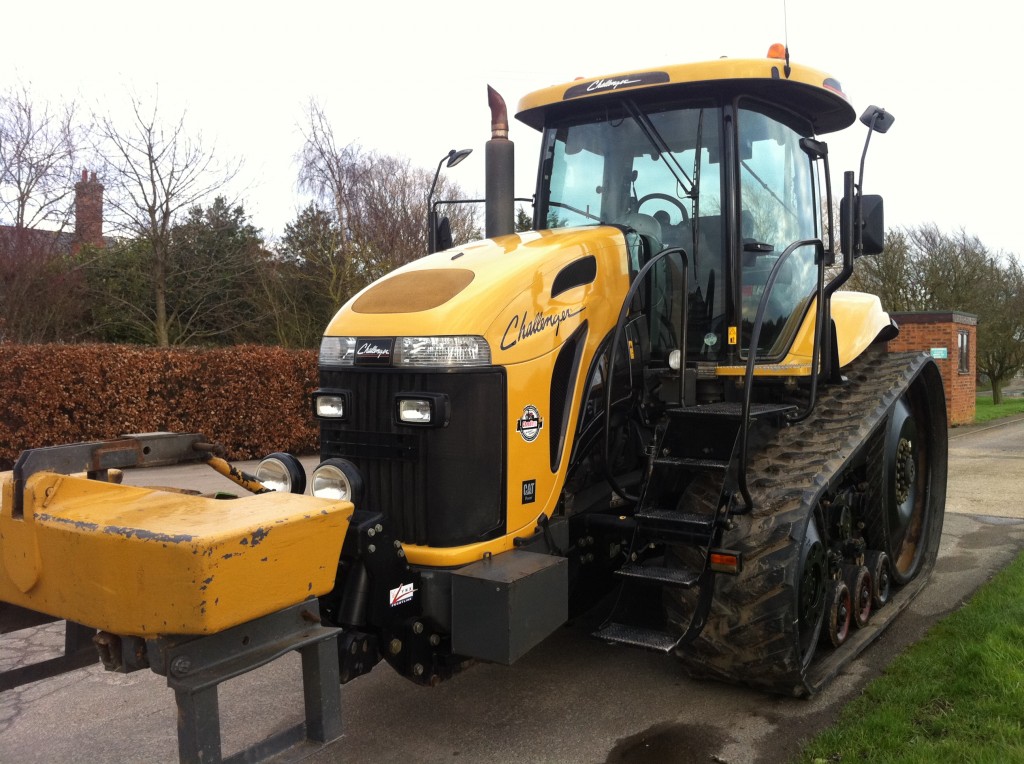For these two Lincolnshire farmers, working their Challengers this way is a deliberate business decision and key element of their farming strategy. To a significant extent, confidence in a Challenger’s longevity can be attributed to its heritage from CAT construction equipment, where 30,000hr design life at heavy duty loads is standard, and ‘disposable engineering’ are still considered dirty words . Of course, for all kinds of machine, longevity and reliability are also critical to maintaining good trade-in and second hand values, which in turn have a major bearing on the cost of ownership for buyers of new machines.
Farmers Challenger tractor Testimonial Case Study – Andrew Branton
Lets hear it for the ‘million-mile’ owners club!
One of the Challengers featured here is a 2003 model with more than 12,000 hours on the clock. For context, a taxi driver in Stirling recently told me with some pride that the 2007 diesel saloon in which we were travelling had 360,000 miles on the clock. Apart from a dodgy gearchange from 2nd to 3rd, it seemed to be running ok. But before getting too impressed by this, the Challenger’s 12,705.3 hours, operating at or close to full power most of the time, is equivalent perhaps to the taxi doing a constant 100mph for 1.2 million miles ! At that time, would it still have the original engine and gearbox? This Challenger does.
It is one of a pair of 765s operated by WD Branton from their base at Willow Tree Farm, Deeping Saint Nicholas, near Spalding in Lincolnshire. Potatoes, sugar beet and combinable crops are the cropping mainstays on 1,822ha (4,500 acres) of land that, according to farm partner Andrew Branton, ranges from grade one silt, through black peaty soils, grade two clay loams to some “very heavy, grade three stuff”. Across all these soil types, the two major concerns are compaction and organic matter depletion. “After a wet summer or autumn, it can take more than two years to restore soil structure to normal,” he says. “And in this part of the country, there is a strong case for returning to mixed farming, as much for a ready supply of manure as additional financial margins.” However, this is ruled out by Andrew for the time being because the family firm’s management horsepower is already fully occupied looking after supermarket supply contracts for potatoes, which he says demand significant attention to customer care as well as crop husbandry and store management.
“Potatoes are our biggest investment by a long way,” he adds, “so we have to allocate them enough attention, labour and other resources. However, it is also imperative that other crops on the farm are looked after properly and timeliness is maintained.” The farm has a seven-strong workforce, and up to four additional casual workers, not including Andrew or his father David. The majority including one full time lorry driver spend much of their time on the potato enterprise but having sufficient labour and machinery resource ensures that work on other crops is also maintained without compromise. Ploughing is the primary cultivation after root crops, before second wheats, and in the autumn (yes, even in 2012) for all spring sowings and plantings, Andrew Branton explains. He says the adoption of tracked pulling power was instigated to minimise soil compaction about 20 years ago with a Track Marshall on metal crawlers. But poor reliability and limited manoeuvrability led to its replacement by all-round dual-wheeled tractors for ploughing.
“These didn’t really offer enough traction,” he adds, leading to a trial in 2003 for their first Challenger, the 765A model now showing 12,000 hours on the clock. The Brantons’ policy was to buy new, maintain it well and not be too impatient to trade in. Over the past 10 years, there has been one significant maintenance job to renew the gears in the final drive. This was prompted pre-emptively when checks during a routine service by Chandlers (Farm Equipment) Ltd. picked up traces of metal debris in the final drive lubricant, and was fixed without any working downtime. The bill was £10,000, which Andrew Branton admits will make some Challenger owners recoil in horror. But spread over the machine’s lifetime to date, he regards £1,000/year as an acceptable cost. The original tracks were replaced at about 7,000 hours and the second set are looking good for longer due to sympathetic driving – in particular, not making tight turns. “We keep a close eye on how spares and repair costs compare with the likely depreciation in trading in for new at 5,000 to 6,000 hours,” he says. “It may not suit everyone, but it’s working for us at the moment.” Asked “when might you call time on the 2003 Challenger?”, Andrew admits to not knowing but says the CAT heritage is significant. “Their industrial loaders and diggers clock up tens of thousands of hours doing really arduous work, so who knows how long ours will last?” Right now, he does expect at least another five years and at least 20,000 hours from the 765A, perhaps many more. To a small extent, this is aided by the Branton farming workload being sufficient to justify two Challengers, which means their 2010 765C can take the lead on the real grunt work. During autumn 2012, ploughing continued when ground conditions were too wet for minimum tillage, which when possible includes tined cultivation to 30cm depth taking care of most compaction issues. At times on ploughed ground, Andrew says working across rather than in line with the furrows helps achieve a better tilth more quickly. “Of course, you’d really struggle to do this on wheeled tractors, but the Challenger’s ride and comfort mean the drivers are happy with working this way when it’s needed.” One other aspect that he applauds is fuel use. Compared with wheeled tractors, he says you can operate in higher gears and at higher speed, which converts what might be viewed as high fuel use per hour into very economical by comparison fuel use per hectare.
In any ‘normal’ year, WD Branton’s two Challengers are more than a match for the workload, with some capacity to spare. But this was not so in 2012, when they were pushed to the limit by reduced availability of suitable working conditions due to the weather. “We had to do some double-shifts to get us out of some tight corners,” Andrew says. “However, we wouldn’t want to rely on this long term.” Like many such farming businesses, this one continues to expand when opportunities become open. Most times recently, this has involved simple rental agreements with people the Branton family know already, and is done selectively to keep unproductive travelling time to a minimum. So maybe 30,000 hours from the 765A is not unreasonable. Just watch this space in about 2030 for an update !
Farmers Challenger tractor Testimonial Case Study – Richard South
Compaction-buster with a ballet dancer’s footprint
When Richard South took on 285 additional hectares (700 acres) in 2010 near Woodhall Spa, he quickly found that it would need some high horsepower therapy to restore productivity. Much of the land was poorly drained and anaerobic as a consequence of serious and widespread compaction, so much so that Mr South’s wheeled tractor was unable to pull the cultivator used on all his other land, not for lack of power but insufficient traction. So Mr South hired a Challenger…job done!
Including the new block of land, PC South & Son’s farming operations based at Holme Farm, Martin Moor, about 12 miles south east of Lincoln cover about 730 hectares (1,800 acres) of combinable crops and sugar beet. The business also lets land to specialist potato and parsnip growers, and has a 34,000 bird broiler breeder enterprise. Soil types vary markedly and include blown sand, heavy sandy clay, black silt and heavy clay. Following his autumn 2010 Woodhall Spa experience, it didn’t take Mr South long to take a calculated risk on a six year old, 5,000 hour Challenger 765, just fitted with a new pair of tracks. It was being sold by Chandlers (Farm Equipment) Ltd, where Challenger specialist Clive Barber assured him about the prestige marque’s reliability record. As it turned out, they discovered significant wear in the rear linkage shortly after delivery, which Richard says Chandlers put right promptly. Even so, he admits to being “slightly wary” at the outset about buying such a machine second-hand, but it was competitively priced at the time and, three autumns later with more than 8,500 hours on the clock, he also admits to being well-pleased with it. Also well pleased is the Challenger’s driver, Tom Searle, who has worked there 18 years and now spends up to 16 hours a day at the wheel during peak workloads. In the main, it pulls a Terminator minimum tillage combination, with tines working at 30cm depth and discs 8cm, for a one pass, stubble-to-seedbed operation. Ploughing is employed before sugar beet and spring bean crops, with a furrow press when conditions allow to help get a more consistent sowing depth, and may be used more says Richard South as long as it doesn’t help the spread of herbicide-resistant blackgrass. This also needs to be consistent with his strategy of running just two wheeled tractors, 220hp and 165hp, and one Challenger. However, minimum tillage has certainly helped improve drainage on heavy land and will remain the mainstay. On the Woodhall Spa block in particular, Richard says min-till at greater depths than is needed elsewhere has seen real improvements in soil aeration and drainage. He credits the Challenger’s light footprint in combination with high traction and power output for improving the timeliness of operations as well as reducing compaction. “It also gets through wet spots without problems,” he adds, “and when one of our parsnip growers got three tractors stuck, it pulled them out easily.”
On fuel use, Richards says the Challenger gets through 27 to 33 litres per hectare cultivating heavy ground, and 21 to 24 on sandy soils. Maintenance-wise, he reckons the annual cost is comparable with a mid-range BMW car, including recent refurbishment of the rear linkages and repair of a spool-valve leak. In common with most Challenger owners, this business continues to seek and take on opportunities to expand, which probably means recruiting another Challenger driver and working double shifts. At the current workload of about 1,200 hours annually, Mr South envisages keeping the current machine for at least another couple of years, by which time it will also have joined the elite ‘Still-Going-Strong-At-11,000-Hours-Club’.
























